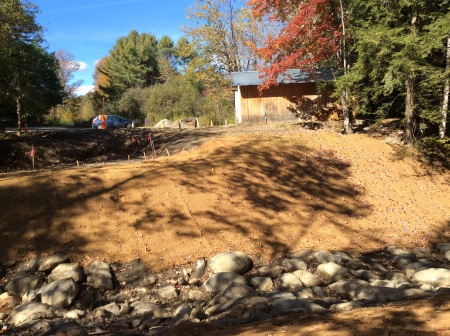Guest post by Kari Jo Spear, Photographer, Novelist, and Daughter of Bob Spear
This post appeared first in our late summer 2014 issue of Chip Notes.
My arm was killing me. Every muscle burned, my fingers cramped, and my shoulder barely fit in its socket any longer. In other words, I was in agony, and it was all my father’s fault. I was furious with those stupid birds of his and his stupid idea about carving every freaking bird that had ever been stupid enough to set its freaking feathers in Vermont. And I was mostly mad about his stupid idea to rebuild the barn on the old foundation next to Gale’s house and keep his stupid birds in there.
I was going to be maimed for life because of this! I was never going to be able to use my right arm again. My fingers were ice cold and I could barely feel them, much less move them. Any doctor would agree this was child abuse. I should be put into foster care and live in a nice, normal apartment in a city and never have to look at another bird again as long as I lived!
And not only that, my hand was sticky, and I hated that more than anything.
But I forced my smile back on. “And what would you like?” I asked a sweet little girl standing in front of me.
“Chocolate, please,” she said with an eager light in her eyes.
“Chocolate it is, then,” I said, and bent over the cooler again, trying to hide my pain.
I had been scooping ice cream for three hours. It had seemed like a really good idea at first. My father was hosting his first open house. It had been advertised all across the media. His “project,” now officially called the Birds of Vermont Museum, was open for visitors. In reality, today’s open house was a test to see if anybody was interested. To see if anybody was insane enough to make the drive all the way out to Huntington to see a bunch of wooden birds. Of course, there was no charge. We were still ages away from having all the permits and stuff that were required to become a business, even one not for profit.
To sweeten the deal, my father was offering a free dish of Ben and Jerry’s ice cream to everybody who showed up that day. For some stupid reason, the ice cream gurus had donated a bunch of bottomless cardboard tubs of the rock hard, icy, sticky stuff for the occasion. And for some stupid reason, I’d thought that was really nice of them and volunteered to be in charge of it.
And now my right arm was totally dead. I didn’t think anything could ever make me hate chocolate. But this afternoon was doing a good job of it.
“Here you go.” I handed the little girl her dish and dragged my eyes to her mom. “And for you?”
“Vanilla, please,” she said.
I decided to hate vanilla, too. I made my poor, abused fingers close around the scoop that lived in the vanilla tub.
“And how were you lucky enough to rate this job?” the mom asked.
I looked up at her as though she were out of her freaking mind. Beyond her, the line of people reached across Gale’s kitchen, down the hall, out the front door, along the path, across the driveway, and down the side of the road all the way to the shop. Which we were now supposed to call the Freaking Birds of Vermont Museum.
“I’m his daughter,” I growled.
“Oh, how marvelous! Your father has such incredible talent! Such patience! Such vision.”
I looked at her again to see if she was sane or not.
“To create such a project! And not want to make any money at it! All that work, to educate people about nature and conservation and – oh, everything! I had to come up here the minute I heard about it. This is something that must happen. I wanted my daughter to be able to say she’d seen it in its earliest days.” She nodded at the little girl dripping chocolate all over the place, who nodded back vigorously. Then the mom looked back at me. “You are so lucky to be part of all this.”
I looked up at her, my arm suddenly feeling a little less leaden and sticky. Did she really mean she hadn’t come all this way for free Ben and Jerry’s?
“I mean, look at the turnout!” she said. “There are hundreds of people here. You must be so proud.”
“It’s amazing,” someone behind her said.
“They look alive,” someone else said.
“I’m going to start a life list,” another voice added.
No, don’t! I almost said aloud. It won’t lead to good things! But then I found myself really smiling as I handed the mom her little dish. “Here you go,” I said. “Thanks so much for visiting the Birds of Vermont Museum today. And what kind would you like, sir? We have chocolate and vanilla and suet with sunflower sprinkles. Just kidding,” I added.
He laughed. “Chocolate, please.”
“Coming right up. Don’t let it drip on your binoculars.”
Everyone laughed. What great people, I thought. What a momentous day!
And what big muscles I’m going to have.
Kari Jo Spear‘s young adult, urban fantasy novels, Under the Willow, and Silent One, are available at Phoenix Books (in Essex and Burlington, Vermont), and on-line at Amazon and Barnes and Noble.
Previous posts in this series:
Part 1: The Early Years
Part 2: The Pre-teen Years (or, Why I’m Not a Carver)
Part 3: Something’s Going On Here
Part 4: The Summer of Pies
Part 5: My Addiction
Part 6: Habitat Shots
Part 7: Growing Up













 Become a Fan on facebook!
Become a Fan on facebook!




Recent Comments